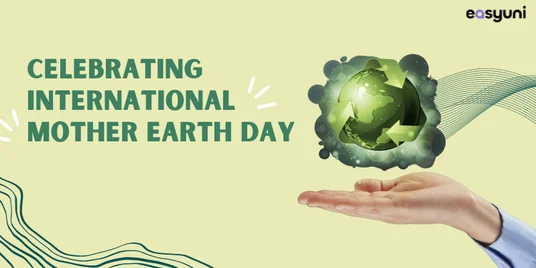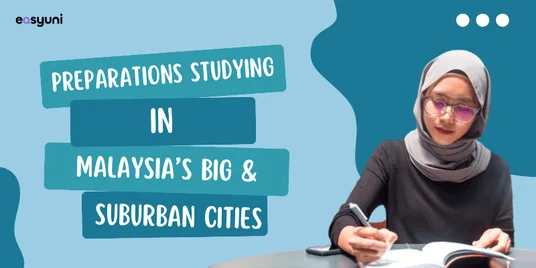Discovering Malaysia: A Historical and Cultural Journey for International Students
April 15, 2024
Anis
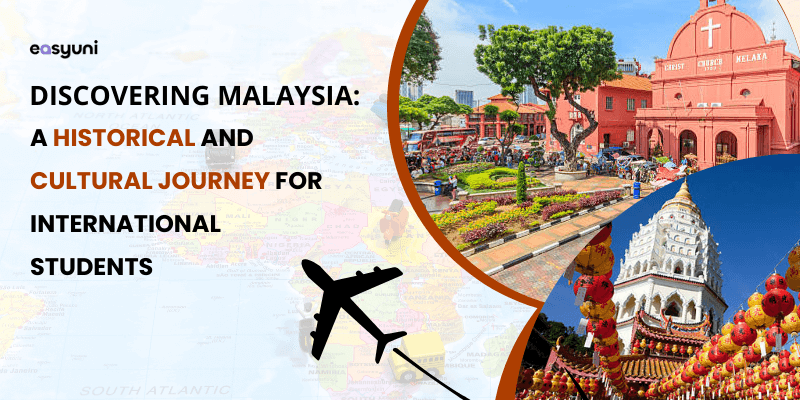
Embarking on a journey to study in another country is more than just academics; it's also an opportunity to explore a new culture.
For international students considering Malaysia as their study destination, discovering the country's rich history and lively culture can be very rewarding.
In this guide, we will share helpful insights tailored specifically to those interested in learning more about Malaysian history and culture, other than its academic side.
What are the key elements of Malaysian cultural heritage?
As an international student preparing to study in Malaysia, you must explore the key elements that define its rich cultural heritage.
Malaysia's diverse society offers you the opportunity to immerse yourself in a melting pot of traditions such as languages, cuisines, and customs, influenced by the country's three major ethnic groups: Malays, Chinese, and Indians.
1. Language diversity
In Malaysia, language diversity is a fundamental part of its cultural heritage. Bahasa Malaysia, also known as Malay, is the official language of the country and is widely used in government, education, and everyday communication.
So, you will likely encounter Bahasa Malaysia in various aspects of your daily life. In fact, part of your university curriculum may involve learning Bahasa Malaysia for a semester.
However, what makes Malaysia particularly fascinating linguistically is its multilingual environment. English is also widely spoken throughout the country and is often used as the language of instruction in higher education institutions.
This means that as an international student, you will have the advantage of studying in an English-speaking environment, which can facilitate your learning and integration into Malaysian society.
In cases where English isn't your first language, you may need to enroll in an English preparatory class and take English tests to enhance your proficiency, which can help you adapt and integrate into Malaysian society more effectively.
Other than Bahasa Malaysia and English, Malaysia boasts a diverse array of languages spoken by its various ethnic communities.
Chinese dialects like Mandarin, Hokkien, and Cantonese are prevalent among the Chinese Malaysian population, while Tamil is commonly spoken among the Indian Malaysian community.
This linguistic diversity presents you with opportunities to immerse yourself in different languages and cultures during your stay in Malaysia.
2. Religions in Malaysia
Religion plays a significant role in Malaysian cultural heritage, providing depth and complexity to the country's cultural tapestry.
While Islam is the predominant religion, Malaysia is home to a diverse array of religious beliefs, including Buddhism, Hinduism, Christianity, and traditional indigenous beliefs.
You will have the chance to experience religious festivals and rituals firsthand, gaining insights into Malaysia's multicultural society.
3. Cultural festivals and celebrations
Cultural festivals and celebrations play a significant role in Malaysian society, offering immersive experiences into the diverse traditions of the nation.
For international students studying in Malaysia, participating in these events is an integral aspect of their overall experience.
These occasions, including Chinese New Year, Deepavali, Ramadan bazaars, and traditional Malay weddings, provide more than mere entertainment; they serve as opportunities for cross-cultural interaction and understanding.
As an international student, you'll have the chance to immerse yourself in these festivities, gaining insights into Malaysian customs, traditions, and values while also sharing your own cultural background with others.
These festivals act as platforms for building connections, fostering friendships, and embracing the diversity that Malaysia has to offer.
They facilitate cultural exchange and create bonds that transcend borders, enriching the educational journey of international students in Malaysia.
4. Traditional arts and crafts
Malaysian arts and crafts comprise a variety of traditional practices that showcase the country's rich cultural heritage.
One such practice is batik painting, which involves applying wax and dye onto fabrics to create intricate nature-inspired patterns, often featuring Malaysian motifs and symbols.
If you're interested in exploring batik painting, you can visit the Central Market at Pasar Seni, where you'll find stores dedicated to this art form.
At these stores, you can select the type of batik motif and symbols you'd like to paint. The shopkeeper will then provide guidance on the painting process, and you'll have around 15-20 minutes to paint your chosen design.
Additionally, you'll find numerous kiosks selling batik apparel for both men and women.
Alternatively, you can also visit the Kuala Lumpur Craft Complex, accessible via the MRT public transport system, where you'll encounter a wider range of batik options and have the opportunity to gain further insight into Malaysian batik craftsmanship.
5. Music and dance
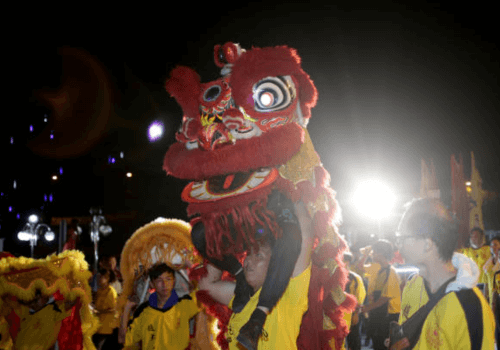
Malaysia's diverse cultural milieu is influenced by its rich blend of ethnicities. Traditional music and dance are integral components that express this diversity.
For instance, the Malay community celebrates dikir barat, a musical tradition characterized by its call-and-response singing accompanied by rhythmic percussion.
These performances, often exploring themes of love, morality, and community, serve not only as entertainment but also as potent tools for cultural preservation.
In addition, the Indian population in Malaysia contributes to the cultural mosaic with bharatanatyam, renowned for its graceful movements and intricate footwork. This dance is frequently showcased during festivals and religious ceremonies.
Similarly, the Chinese community in Malaysia presents the mesmerizing lion dance, particularly during the Chinese New Year festivities.
This gravity-defying performance symbolizes prosperity and good fortune, enriching Malaysia's cultural landscape with its vibrant traditions.
What are some must-visit cultural and historical landmarks in Malaysia?
Malaysia boasts a rich history with influences from various cultures, a heritage reflected in its many historical landmarks scattered throughout the country.
Here are some must-visit cultural and historical landmarks in Malaysia:
1. National Museum, Kuala Lumpur
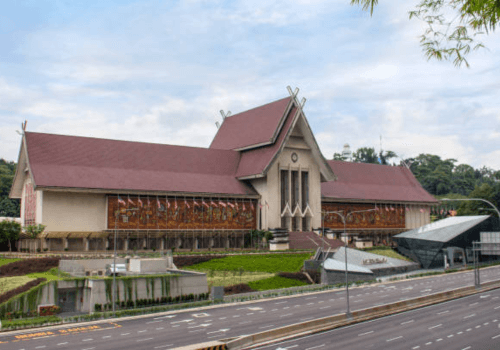
If you're keen to learn more about Malaysia's history, a visit to the National Museum in Kuala Lumpur is a must. Located at the heart of the city, this museum offers an excellent starting point for exploring the country's rich heritage.
You can easily access the National Museum by taking the MRT public transport system and getting off at the Muzium Negara station. It's just a brief walk from there to reach the museum's entrance.
Upon entering, you'll come across engaging displays covering different historical periods.
These range from insights into the earliest settlers of the area during prehistoric times to exploring the colonial era, where European influences blended with local traditions, shaping the nation's quest for independence.
Additionally, you'll gain insights into modern Malaysia, marked by its diverse cultures, population, and rapid economic development.
A visit to the National Museum offers a deeper understanding of Malaysia's cultural nuances, ethnic diversity, and historical events.
This newfound knowledge can facilitate your transition and cultivate a sense of belonging in your new environment.
2. Melaka
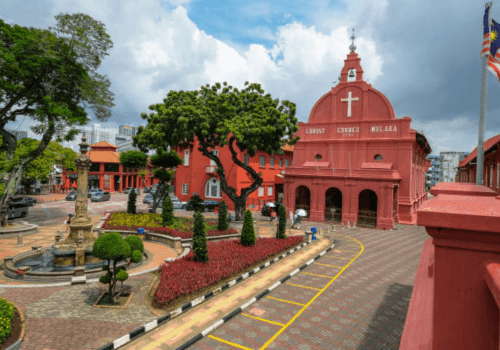
Melaka, located on the Malay Peninsula, served as a prominent trading port during the 15th and 16th centuries. Today, it holds the distinction of being a UNESCO World Heritage Site, boasting numerous historical landmarks that offer insight into its past.
Among these landmarks stands the A Famosa Fortress, a crumbling Portuguese fort that serves as a reminder of the European colonial presence in Malaysia.
Additionally, you can explore the Stadthuys, a preserved Dutch-built town square transformed into a museum, offering a comprehensive narrative of Melaka's colonial era.
Another noteworthy site is St. Paul's Church, the remnants of a 16th-century Portuguese church, offering insights into Melaka's Christian roots.
Other than these historical landmarks, Melaka offers you a diverse array of cultural experiences that showcase the city's vibrant heritage and lifestyle.
One such experience is sampling Nyonya cuisine, a delightful fusion of Chinese and Malay flavors. You can indulge in dishes like ayam pongteh and Nyonya laksa at local eateries.
Another appealing destination is Jonker Street, a lively night market filled with traditional crafts, clothes, accessories, and souvenirs.
The lively atmosphere of Jonker Street gives you an immersive experience of Melaka's vibrant street life, making it a perfect place to interact with locals, enjoy local cuisine, and purchase souvenirs to remember your trip.
3. Penang
Georgetown, another UNESCO World Heritage Site situated on Penang Island, is a state in Malaysia that beckons you to explore its rich cultural heritage. This city boasts architectural influences from Malay, European, Chinese, and Indian cultures.
As you wander through the streets of George Town, you'll discover numerous architectural marvels, including colonial-era buildings, clan houses, and temples.
Each structure tells a unique story of the city's diverse heritage, showcasing the amalgamation of cultures that characterizes Malaysia.
Additionally, while in Penang, you can visit other notable architectural landmarks such as Khoo Kongsi, a traditional Chinese clan house of which only five remain in Penang.
This architectural gem offers insights into the history of the Kongsi family, with a museum on-site providing further details.
Moreover, you may stumble upon captivating street art throughout the town. A dedicated trail of street art allows you to explore these artistic treasures either by bike or on foot.
Furthermore, vibrant, colorful streets adorned with beautifully painted buildings provide ideal backdrops for memorable photographs to share on your social media platforms.
4. Sultan Abdul Samad Building, Kuala Lumpur
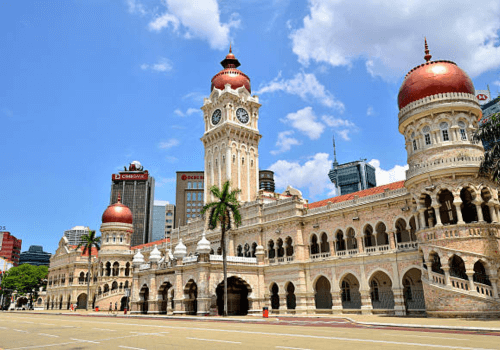
The Sultan Abdul Samad Building, an example of Moorish Revival architecture, located in Kuala Lumpur.
Once serving as the administrative center of British Malaya, this iconic structure, characterized by its horseshoe arches, domes, and minarets, has emerged as a prominent symbol of Malaysia's national pride.
With its intricate details and ornate features, the Sultan Abdul Samad Building captures attention effortlessly. Today, it not only serves as a reminder of Malaysia's colonial past but also stands as a symbol of its journey towards independence.
The building remains a hub for cultural and national celebrations in Kuala Lumpur. Throughout the year, it hosts events that highlight Malaysia's rich heritage and commemorate significant occasions.
During Malaysia's Independence Day celebrations on August 31st, it takes center stage, providing a backdrop for lively parades, cultural performances, and flag-raising ceremonies.
Beyond its historical importance, the Sultan Abdul Samad Building's prime location in Merdeka Square makes it an ideal venue for various events.
These include cultural festivals, art exhibitions, and public gatherings, all aimed at celebrating Malaysia's diverse heritage and fostering cultural exchange.
5. Royal Selangor Visitor Centre
Royal Selangor Visitor Centre is a must-see destination for those fascinated by Malaysia's industrial and cultural heritage.
Established in 1885, it goes beyond being a mere factory, standing as a living testament to the enduring tradition of pewter craftsmanship.
During your visit, you'll embark on a guided tour that takes you through the entire process of transforming molten metal into exquisite pewter creations.
You'll have the opportunity to witness skilled artisans performing their craft, from pouring the liquid metal into molds to meticulously hand-finishing each piece to perfection.
You can also participate in a hands-on workshop and cast your very own pewter souvenir. It's an amazing opportunity to immerse yourself in this traditional craft and create a personalized memento of your Malaysian adventure.
For more information and to plan your visit, you can visit their official website for details on pricing and booking.
Additionally, the Royal Selangor Visitor Centre is conveniently accessible via public transportation.
You can take the LRT and get off at Wangsa Maju LRT station. From there, you can easily arrange an e-hailing service to reach your destination.
What are some traditional Malaysian cuisines that reflect its cultural diversity?
Malaysia's food scene is a rich tapestry of flavors, reflecting the diverse cultural heritage of the nation.
Each ethnic group contributes its own culinary traditions, resulting in a varied gastronomic landscape.
1. Rendang
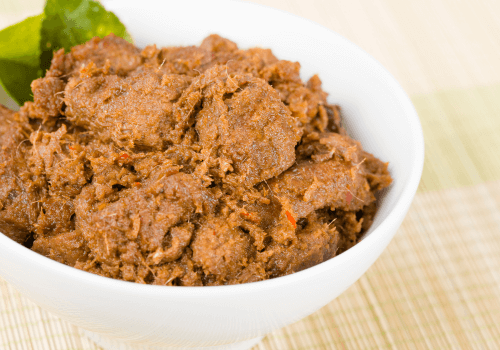
Rendang, a slow-cooked meat dish infused with a medley of aromatic spices, coconut milk, and herbs, holds a special place in Malaysian cuisine.
It is particularly popular among Malaysians, especially Malays, during festive occasions such as Hari Raya Aidilfitri (Eid al-Fitr) and Hari Raya Aidiladha (Eid al-Adha).
However, it is also embraced by Malaysians of different ethnic backgrounds and is served at family gatherings and special occasions, transcending cultural boundaries.
Rendang is typically enjoyed by pairing it with other traditional dishes such as serunding, lemang, or ketupat. You can also eat rendang together with nasi lemak as your side dish.
2. Yee Sang
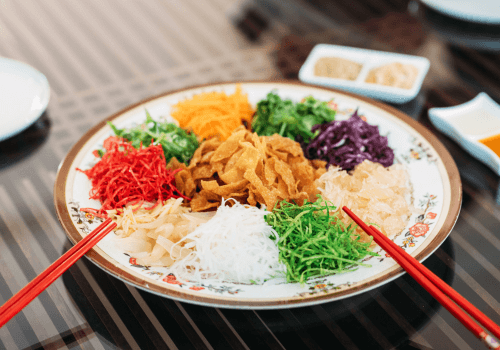
Yee Sang, a raw fish salad commonly enjoyed in Malaysia, particularly during the Lunar New Year festivities, holds significance beyond its delightful taste—it embodies a cultural tradition symbolizing unity and heritage.
Comprising various essential components, each carrying its own symbolic meaning, Yee Sang is a blend of flavors and textures.
Raw fish, typically salmon but sometimes tuna or yellowtail, represents abundance and prosperity, while shredded vegetables like white and green radish, carrots, and ginger symbolize vitality.
Sweet plum sauce serves as the dressing, adding a sweet flavor that symbolizes prosperity and the sweetness of life.
Additionally, garnishes such as crushed peanuts, fried shallots, sesame seeds, and even gold flakes enhance the dish, providing a diverse range of textures and flavors for a truly festive experience.
The ritual of Yee Sang is a communal tradition, with the salad served on a large platter for all to partake in together.
The centerpiece of the ritual is the "Lo Hei" or Prosperity Toss, where participants use chopsticks to raise the ingredients high in the air while reciting phrases symbolizing good fortune and prosperity for the upcoming year.
3. Dumplings
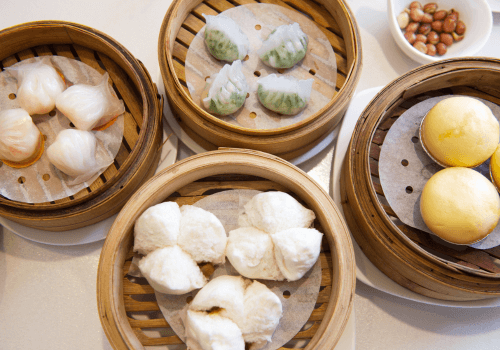
Dumplings, known as "jiaozi" in Chinese, are an integral part of Lunar New Year celebrations, symbolizing wealth and family togetherness.
The process of making dumplings is a communal affair, often involving multiple generations of family members gathering together in the kitchen to prepare the ingredients and assemble the dumplings.
It's a time-honored tradition that fosters bonds between family members and creates cherished memories.
During Lunar New Year celebrations, dumplings are traditionally eaten on New Year's Eve as part of the reunion dinner, symbolizing the coming together of family members to usher in the new year with good fortune and happiness.
They are also enjoyed throughout the festive period, often served as a snack or appetizer during family gatherings and social events.
4. Muruku
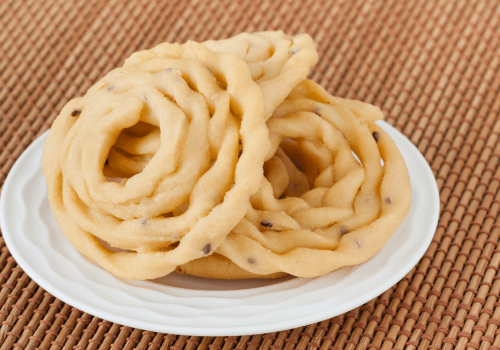
Muruku, a beloved treat during Malaysia's Deepavali festivities, holds a special significance for celebrants during this joyous occasion. This savory snack, renowned for its crispy texture and fragrant spices, is a delightful addition to the festivities.
In Malaysia, murukkus are often prepared in large batches before Deepavali and shared generously with family, friends, and neighbors as a symbol of goodwill and celebration.
5. Adhirasam
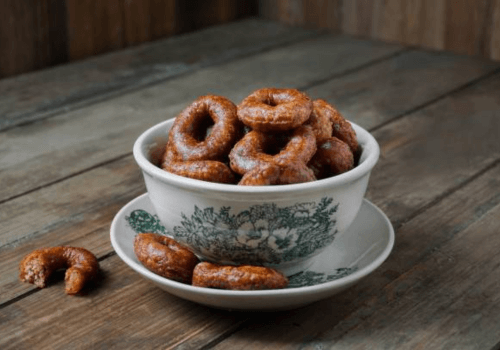
Adhirasam is a traditional South Indian sweet delicacy that holds a special place in the culinary culture of Tamil Nadu, particularly during festive occasions like Deepavali.
This delectable sweet is made from a simple mixture of rice flour, jaggery (unrefined cane sugar), and sometimes flavored with cardamom powder.
In conclusion, studying in Malaysia provides opportunities to international students to discover a wide range of cultures, which helps them better understand different historical and cultural backgrounds and enhances their education beyond classroom settings.
Kickstart your education in Malaysia
We'll help you find and apply for your dream university
You might be interested in...
- Raising Awareness of the Threat of Microplastics Pollution on International Mother Earth Day
- Essential Tips for International Students Studying in Malaysia's Big and Suburban Cities
- Misconceptions About Studying in Malaysia: Insights for International Students
- The Role of Education in Promoting Health Equity: Lessons from World Health Day 2024
- Studying Abroad Tips: What Should You Do Before Coming to Malaysia?
- International Students' Guide to Success in Malaysian Research Programs
- Returning Home or Staying Put: Planning Your Career Path After Studying in Malaysia
- Crafting a Greener Tomorrow: Empowering Change through Zero Waste and Upcycling Practices
- Malaysian Higher Education's Global Outreach: Collaborations with International Institutions
- Initiatives by Universities in Malaysia to Prepare Students for Globalization






